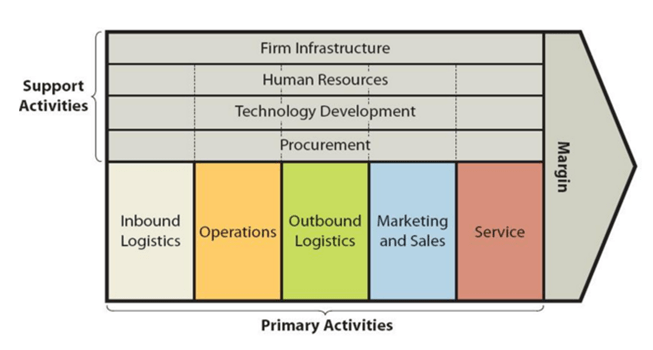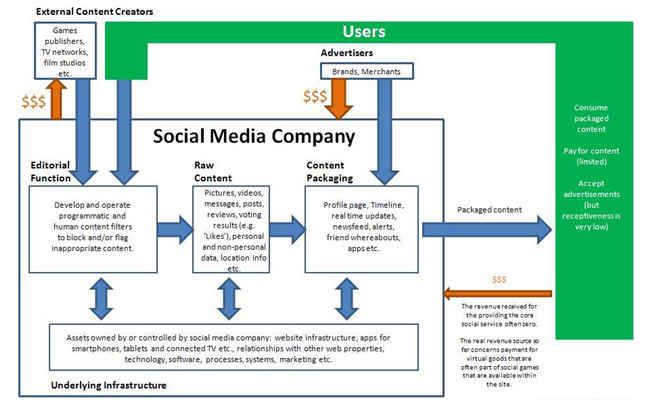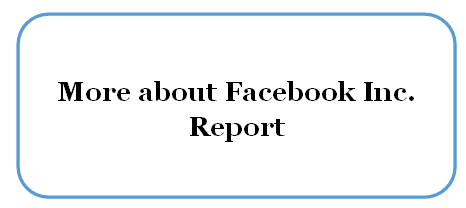Facebook Value Chain Analysis
Value chain analysis is a strategic analytical tool that can be applied to analyse business activities to be able to identify those activities that contribute most the overall competitive advantage of the business. Facebook value chain analysis provided below discusses sources of competitive advantage of the social media company by referring to its primary and support business activities. Figure 1 below illustrates the essence of value chain analysis.
Figure 1 Facebook Value Chain Analysis
Primary Activities
Inbound logistics
Facebook Inc. inbound logistics refers to ways the company acquires resources and uses according to its needs. The range of resources used by the social media giant includes hardware, various types of technologies and office supplies. Generally, value chain analysis framework analyses the processes of receiving and storing raw materials until their transformation into the final goods.
However, due to Facebook Inc.’s business model illustrated in Figure 6 below, tangible resources such as hardware and technology used by the company are only secondary in their nature and the primary resources used to attract the customers are intangible. Specifically, Facebook offers its customers unique intangible ‘products’ of informational nature, i.e. content. From this point of view, inbound logistics of content is highly cost-effective since the content is uploaded by users of in the forms of texts, pictures and videos without any additional costs for the business.
Operations
Facebook is available in more than 90 different languages, and the company has offices or data centres in more than 30 countries around the world. Moreover, there are five support offices and more than 35 sales offices located globally.[1] Approximately 84.5% of Facebook daily active users are outside the US and Canada.[2] As it is illustrated in Figure 2 below, Facebook operations mainly involve the transformation of raw content into user-friendly format via profile page, timeline, real time updates, news feed, alerts, friend whereabouts, apps etc. With more than 1.13 billion daily active users and 1.03 billion mobile daily active users[3], Facebook is the most popular social networking site in the world. An extensive amount of sophisticated hardware, software and data centres, as well as, more than 12500 employees, including technical employees, play a critical role in providing an interrupted service to such a large customer base.
Figure 2 Facebook Inc. business operations mapping[1]
Main sources of value for Facebook Inc. business operations include improvement of content packaging practices in a consistent manner. Specifically, the social media site is engaged in critical evaluation of its existing product portfolio with the view of enhancing user experience and introducing new products regularly.
Outbound logistics
Generally, outbound logistics relates to warehousing and the distribution of finished goods to customers. For Facebook Inc., outbound logistics relates to the provision of the packaged content to its users via its respective sites and applications. The e-commerce nature of the business is the main source of value addition for Facebook Inc. since there are no additional costs for the business related to the outbound logistics aspect of the business.
Moreover, in 2016 the company introduced a set of initiatives to reduce the loading time of links, by pre-fetching advertisers’ sites and this measure is estimated to shorten mobile site load times by 29%, or 8.5 seconds. This and other similar initiatives provide additional competitive advantages for Facebook’s outbound logistics aspect of the business.
Marketing and sales
The number of Facebook employees engaged in marketing and sales increased by 32 per cent in 2015. Generally, for 2015, 2014, and 2013, advertising accounted for 95%, 92% and 89%, respectively, of the company’s revenues. The utilization of 7P’s of marketing by Facebook benefits from the place and price elements of the marketing mix. The social media company has been consistently expanding its target customer segment since its establishment in 2004 and it employs multi-segment type of positioning, targeting multiple customer segments at the same time with different social media platforms.
Service
The company does not have physical customer service offices due to the online nature of the business. Range of Facebook customer service platforms include phone number for customers based in the USA, online help community for all customers and options tool bar within the site that is intended to assist its users with technical issues…
Facebook Inc. Report contains a detailed discussion of Facebook Value Chain Analysis. The report also illustrates the application of the major analytical strategic frameworks in business studies such as SWOT, PESTEL, Porter’s Five Forces and McKinsey 7S Model on Facebook Inc. Moreover, the report contains analysis of Facebook marketing strategy, leadership and organizational structure and discusses the issues of corporate social responsibility.
[1] Annual Report (2015) Facebook Inc.
[2] Our Mission (2016) Facebook Inc. Available at: http://newsroom.fb.com/company-info/
[3] Stats (2016) Facebook Inc. Available at: http://newsroom.fb.com/company-info/
[4] Source: www.generatorresearch.com



